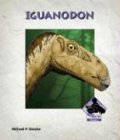-
Triceratops
Charles Lennie
Hardcover (Capstone Classroom, Aug. 1, 2016)Travel millions of years back in time to meet the triceratops! Learn everything from what the triceratops looked like to what it ate, and even where their goliath fossils have been found today. Complete with a More Facts section and bolded glossary terms. Young readers will gather basic information about the triceratops through easy-to-read, simple text alongside colorful images! Aligned to Common Core Standards and correlated to state standards. K
K
-
Corythosaurus
Christy Devillier
Library Binding (Buddy Books, Jan. 1, 2004)Describes the physical characteristics, habitat, and behavior of a crested, duck-billed dinosaur that lived about seventy million years ago. P
P
-
A Jurassic Mystery: Archaeopteryx
Matteo Bacchin, Mark Norell, Marco Signore
Hardcover (Abbeville Kids, Sept. 2, 2008)The second volume in a series of six comic-book adventures that bring the dinosaurs back to life. A Jurassic Mystery, the second title in Abbeville's Dinosaurs series, features over 60 pages in full color. It is a paleontological whodunit set in the late Jurassic period, 150 million years ago, at a place that now lies in Germany. It investigates the suspicious death of an archaeopteryx, an early species of bird descended from the dinosaurs. In Abbeville’s Dinosaurs series, a talented artist and a noted paleontologist have teamed up to re-create the vanished world of the dinosaurs for young readers. Each volume in the series tells the story, in comic-book form, of a different dinosaur living in its particular geological time and place. The narrative is entertaining, while all the details of the dinosaur’s behavior and its encounters with other species are rendered with scientific accuracy. At the back of each volume, meanwhile, are several short essays, abundantly illustrated with original drawings and photographs of fossils, that explain more about the creatures and geographical settings encountered in the comic.
-
Tyrannosaurus Rex
Charles Lennie
Library Binding (Abdo Kids, Sept. 1, 2014)Learn about the Tyrannosaurus Rex, what it ate and where it was found. I
I
-
Aladar's Story
Kathleen Weidner Zoehfeld, Walt Disney Pictures, Judith Clarke, Brent Ford, John Alvin
Hardcover (Disney Pr, May 1, 2000)A richly illustrated picture book retells the story of Disney's newest animated masterpiece in which young Aladar must use the lessons of teamwork and respect learned from his adopted family to help his fellow dinosaurs survive. 75,000 first printing. K
K
-
Spinosaurus
Christy Devillier
Library Binding (Buddy Books, Jan. 1, 2004)Describes the physical characteristics, habitat, and behavior of a big, meat-eating dinosaur that is famous for the tall spines along its back. R
R
-
Ankylosaurus
Michael P. Goecke
Library Binding (Buddy Books, Jan. 1, 2002)Describes the physical characteristics and behavior of the armored dinosaur Ankylosaurus. M
M
-
Brachiosaurus and Other Long-Necked Herbivores
David West
Library Binding (Gareth Stevens Pub Learning library, Aug. 15, 2010)Introduces the class of dinosaurs known as long-necked herbivores, describing the time period in which they lived, their various types, and the physical characteristics of each type, including such examples as Amargasaurus, Europasaurus, and Titanosaurus. O
O
-
Brachiosaurus and Other Long-Necked Herbivores
David West
Paperback (Gareth Stevens Publishing, Aug. 15, 2010)The sauropod group of dinosaurs included the largest animals ever to walk the Earth. Sauropods were plant eaters with very long necks. The giant Brachiosaurus likely ate more than 400 pounds of plants a day. The enormous Omeisauruss neck made up more than half of the length of its entire body. Sauropods also had long tails, sometimes with dangerous spikes on them. Scientists believe the lengthy Diplodocus and other sauropods used their long tails as weapons against predators. Inside, readers will learn about these and many others long-neck herbivores. O
O
-
Brachiosaurus
Michael P. Goecke
Library Binding (Buddy Books, Jan. 1, 2002)Describes the physical characteristics and behavior of the large dinosaur Brachiosaurus. M
M
-
Allosaurus
Grace Hansen
Library Binding (Abdo Kids Jumbo, Sept. 1, 2017)Looks at the meat-eating dinosaur, with information on their physical characteristics, habitat, diet, when they lived, and where their fossils have been found. O
O
